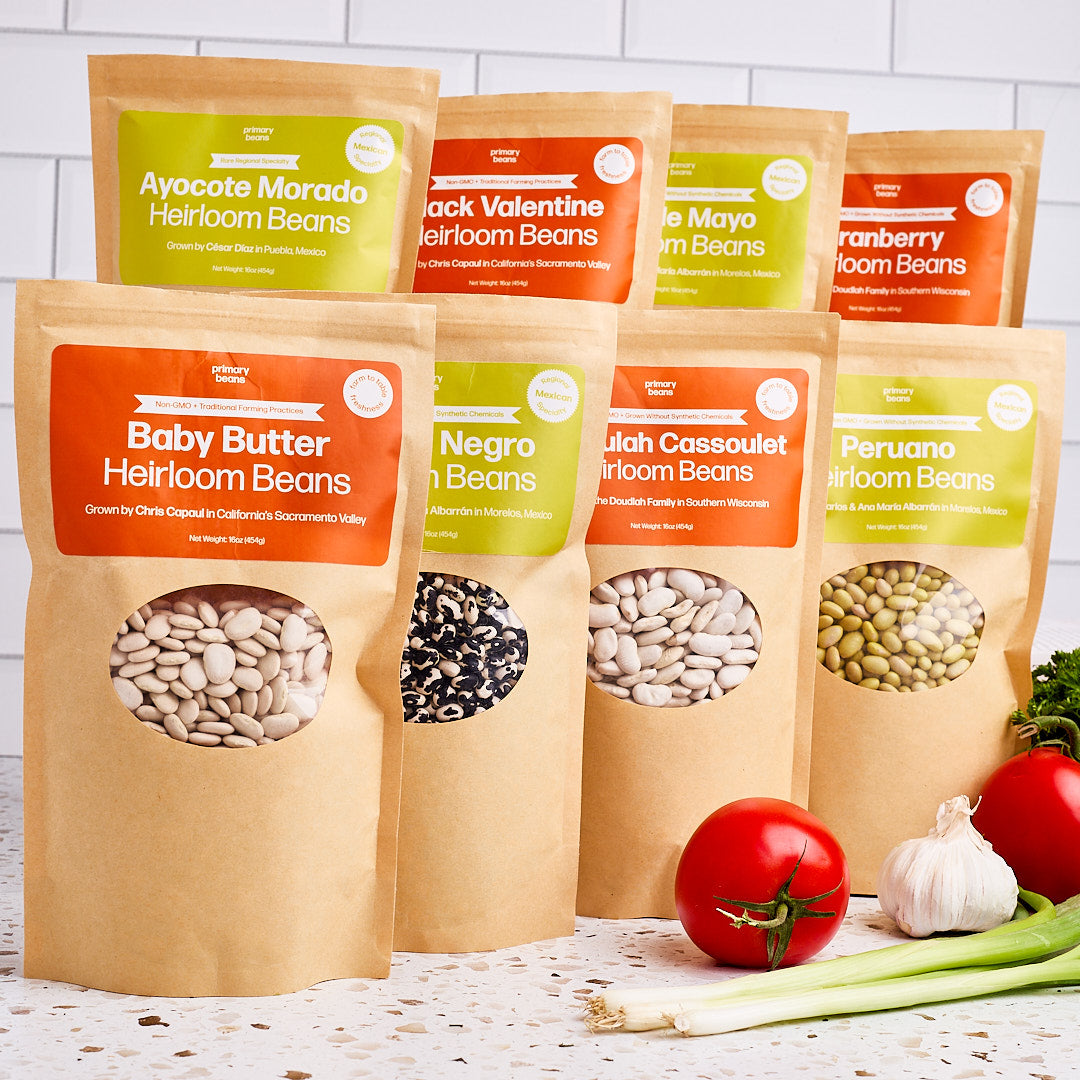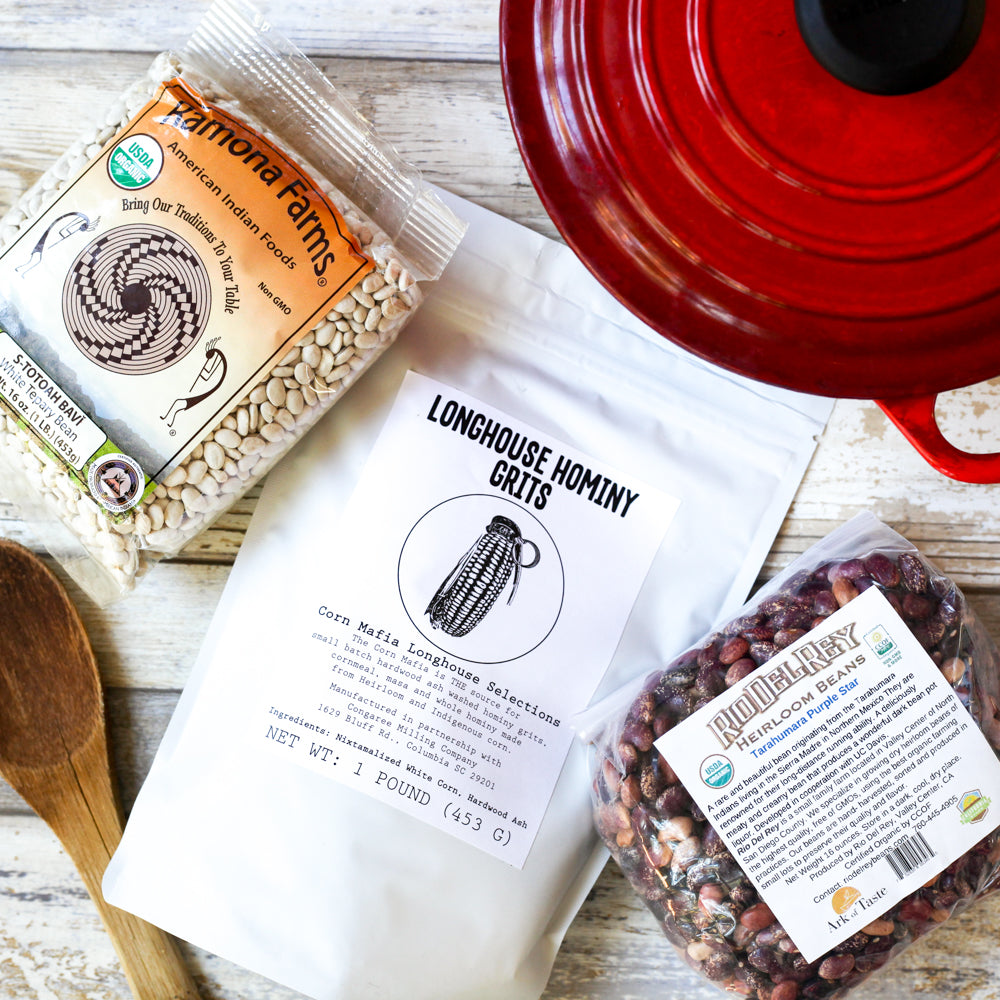10.99 FLAT RATE SHIPPING
10.99 FLAT RATE SHIPPING
SHOP

June 2025 Heirloom Bean and Grain Club
May 29, 2025 8 min read
June's Heirloom Bean and Grain Club brings together three extraordinary treasures that showcase the incredible diversity of ancient grains and heirloom beans. The Rio Zape, beloved by chefs and bean nerds alike, delivers a rich, meaty flavor that has made it a cornerstone of Mexican cuisine for generations. The striking Calypso beans, with their dramatic contrasting colors, offer a creamy texture and mild, sweet taste that makes them perfect for both hearty stews and elegant salads. Completing this month's selection, the vibrant blue masa from our friends at Masienda represents centuries of traditional farming wisdom, milled from heirloom corn varieties that bring both stunning color and deep, earthy flavor to your kitchen.
THE BEAN AND GRAIN BOX CONTAINS:
Organic Rio Zape Beans, Organic Calypso Beans, Heirloom Blue Masa
THE BEAN ONLY CONTAINS:
Organic Rio Zape Beans, Organic Calypso Beans, Organic Mitla Black Tepary Beans
OUR CUSTOMER PORTAL
You can easily claim rewards, add to your next shipment and so much more! We made a video walking you through exactly how easy it is to add some goodies to your order and get cash back. WATCH THE VIDEO.
NEW TO THE CLUB? Check out our blogposts with everything you need to know to get the most out of your membership in the heirloom bean and grain club.
How To Cook A Perfect Pot of Beans
The Definitive Guide To Cooking Beans


ORGANIC RIO ZAPE HEIRLOOM BEANS
Beloved by chefs and revered as "the noblest bean" by The Washington Post, this 100% organic heirloom bean comes to us from Blue House Farms. It will blow your mind as a refried bean (as featured in Food & Wine Magazine), and it makes an amazing mole taco!
The Rio Zape bean is a true Mexican heirloom treasure, beloved for its beautiful mottled appearance and exceptional flavor. These medium-sized beans showcase a gorgeous cream-colored canvas painted with intricate maroon and purple streaks that make each bean a work of art. Originally cultivated in the mountainous regions of Mexico, particularly in Chihuahua and Durango, the Rio Zape is beloved by all lucky enough to have it. The name "Rio Zape" comes from the Zape River region where these organic heirloom beans have been grown for generations.
What sets Rio Zape apart is its remarkable ability to hold its shape during long cooking while developing an incredibly rich, almost meaty flavor. The beans create a luxurious, dark broth that's perfect for hearty dishes. Their firm texture and robust taste make them ideal for Mexican classics like frijoles de la olla, but they're equally at home in contemporary dishes where you want beans that can stand up to bold flavors and extended cooking times.
HOW TO ENJOY THEM
The Rio Zape gives off a delicious dark gravy and has a creamy texture and a complex flavor with a hint of chocolate. They are a natural fit for any mole dish. Whether you make your own as in our recipe for Rio Zape Mole Tacos or use a pre-made mole sauce like this Oaxacan Mole Sauce from Bunches and Bunches it's a match made in heaven. It makes an excellent refried bean that is so simple to make it can hardly be called a recipe. With your refried beans I highly recommend making a tostada with the blue corn masa and if you've got some leftover beans from the pot try our new Oaxacan Rio Zape Breakfast Bowl.
ABOUT THE FARM
Blue House grows drop dead gorgeous beans from the fertile land in Pescadero and San Gregorio, California. Ryan Casey became interested in farming in college while taking agriculture courses. After completing an apprenticeship at the Center for Agroecology and Sustainable Food Systems and working on several farms, he decided to start an organic farm. The farm started in 2005 on 2 acres and has steadily grown to over 75 acres in production. Farming in two different microclimates allows Blue House Farm to grow over 50 types of certified organic farm products. Among the lettuce, tomatoes, herbs and peppers Blue House Farm grows excellent organic beans.

ORGANIC CALYPSO BEANS
The calypso bean, also known as the orca bean or the yin and yang bean, showcase beautiful half black, half white markings that deepen with age. The colors will definitely catch your eye but they offer much more than that. The petite bean is round, ovulate and doubles in size when cooking.
The contrast between the deep black cap and creamy white body creates a bean so distinctive that it's instantly recognizable, making it a favorite among chefs and home cooks who appreciate ingredients that bring both visual appeal and exceptional taste to the table.
Despite their bold appearance, Calypso beans offer a surprisingly mild, sweet flavor with a smooth, creamy texture that makes them incredibly versatile. They cook relatively quickly compared to larger varieties and hold their shape beautifully, making them perfect for dishes where you want the beans to remain intact and showcase their stunning pattern. The beans maintain much of their dramatic coloring even after cooking, though the black areas may fade slightly to a deep purple-brown.
 WHAT TO DO WITH THEM
WHAT TO DO WITH THEM
Smokey Calypso Tomato Skillet With Crispy Shallot
 ABOUT THE FARMER
ABOUT THE FARMER
Fifth Crow Farms is an organic family owned farm in Pescadero, California. Grounded in a values-based approach to land stewardship, Fifth Crow Farm is a dynamic and diversified organic farm in Pescadero, CA. Founded in 2008 with a shoestring budget, a supportive local community, and ambitious dreams, they strive to bring eaters the highest quality, best tasting, and most nutritious food possible.
Fifth Crow Farm wants their farm to be more than a business: they strive to make it an engine for positive change in the food system. They are stewarding the land in a way that not only respects but improves habitat for wildlife and builds better soil for future farmers. They also believe in creating a healthy, fulfilling, and fair work environment, and providing their customers with the best tasting, most nutritious, highest quality food possible.


HEIRLOOM BLUE CORN MASA HARINA (BEAN + GRAIN VERSION)
Non-GMO, Gluten free and made from the best, traditional heirloom corn in Mexico. Blue corn was originally cultivated by the Hopi people in what is now known as New Mexico long before Spanish explorers set foot on Turtle Island. Remember that at the time there wasn't an "America" and "Mexico" and there wasn't a boarder dividing this continent. There were at least 5 distinct varieties developed by the Hopi and those made their way across the land and were adopted far south. The Tarahumara northern Mexican variety Tarahumara Maiz Azul, cultivated in the high deserts bordering the Sierra Madre in Northern Mexico.
Once you try Masienda corn flour, you won't go back. The deep flavors are made from the highest quality ingredients and grown in the same environment for hundreds of years. In small batches, the heirloom corn is cooked, slow dried, and milled to perfection with no genetic modification. With a trace of lime and the natural, traditional maize flavor, this masa will change your life.
 WHAT TO MAKE
WHAT TO MAKE
This blue masa is amazing for tortillas, tostadas, tamales, pupusas, arepas and more. Masa can be used like a blank canvas, there is so many possibilities! Each bag makes 86 6" tortillas. If you're new to cooking with fresh masa start out with our super easy oil free tostadas. Or try your hand at arepas. These are basically little sandwich buns, entirely gluten free and delicious. Here's a video tutorial from Masienda to show you how it's done. Stuff them with anything you like from cheese to meat or even a bean filling. This delicious recipe for Columbian Corn and Cheese Arepas is absolutely worth a try. If you've made too much masa use leftover beans and masa to make bocoles the next night just like they do in Mexico. They are deliciously crispy on the outside and soft and chewy on the inside.
MAKING TORTILLAS
If you've never made a fresh corn tortilla you are in for a major treat. You may never go back to store bought, it's an entirely different world. First off you will want a tortilla press. I found mine at my local grocery store, but you might need to go to a latin market or order one online.
1. Fill a measuring cup with warm water.
2. Slowly add the water to one cup of masa in until fully incorporated but not sticky.
3. Adjust consistency by adding more masa if sticky, or water if too dry.
4. Heat griddle or skillet to medium heat.
5. Roll masa into pingpong size balls and cover with a damp towel.
6. Line tortilla press with plastic (cut open a plastic grocery bag for best results).
7. Place masa ball in press and press firmly.
8. Peel tortilla off plastic onto your hand, then onto the hot pan.
9. Wait until tortilla moves freely and flip.
10. Pat edges with a cloth napkin or tea towel.
11. Flip again and pat edges until slightly dry with cracks on both sides.
12. Keep warm in towels and repeat for next tortilla.
Check out this video from Masienda on how to make a tortilla that puffs.

ABOUT THE MAKER

ORGANIC MITLA TEPARY BLACK BEANS (BEAN ONLY VERSION)
Hailing from the Mitla Valley of Oaxaca, Mexico, these, small dense black beans are an exceptionally flavorful variety of tepary bean. Tepary beans are among the most drought tolerant and ancient beans in the world. There is evidence that they were grown and eaten over 5,000 years ago in Mexico. The real bean geeks will appreciate that this little bean is the subject of some botany debate. Some say it is not a true tepary, Phaseolus acutifolius, but is instead a member of the Phaseolus vulgaris species. Regardless of it's genetics we think it's delicious!
WHAT TO DO WITH THEM
Mitla Black Tepary is a small bean with a firm, creamy texture. Its delicate nutty- sweet flavor complements other southwestern classics like chiles, cumin, and cilantro in soups, stews, and refried bean dishes. As is the case with many landrace varieties it requires longer cooking time which of course can be shortened by pre-soaking.
Recent Articles
About Us
Foodocracy is dedicated to creating a more sustainable and independent food system. We support small, independent farms across the nation.
Get impossible to find beans and grains shipped direct to your doorstep each month from small family farms.
We support small, family owned farms across the nation. Did you know that farmers only make an average of 10 cents on every dollar you spend at the supermarket? Working directly with farms and not middle men ensures that more money goes back to the people actually growning your food.
Get 10% Off
Sign up for delicious recipes and special offers.
**Regularly priced items only.





